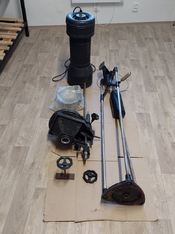The fact that you'll only do B&W helps to keep things simple!
Good; this gives you a simple option you could consider, as the former will be a little easier. Components would be something like this:
* 20-50W warm white COB LED for direct AC operation; something like this:
https://www.aliexpress.com/item/1005007023067678.html
* Suitable COB LED heatsink, e.g.
https://www.aliexpress.com/item/32754202850.html
* I'd recommend also getting a fan that mounts onto the heatsink; most of these are 12VDC so you'll need a small 12VDC wall wart power supply to power it from.
* You can use any regular enlarger timer and plug the LED into this.
In this setup there may be a very slight afterglow to your COB LED (but usually it's insignificant) which you'll just have to live with. If it's bothersome, try some other LEDs until you find one that doesn't exhibit this behavior (they're cheap anyway). The addressable RGB LEDs in the 'fancy' option above don't have this problem anyway.
This approach requires no microcontroller or coding; you just use a regular enlarger timer. You'll use Multigrade filters like with any bulb-based enlarger. You will still have to build a diffusion box so that the illumination of your negative is even. This challenge will be pretty much the same as with the fancy option I'll discuss below.
If you want to use "dial-a-grade" functionality where you basically have similar functionality to an Ilford 500 head, where you set the contrast grade and exposure time on a little screen by punching some buttons, you could build a more fancy version. You would need, for instance:
* Four or more 10W addressable 'smart pixel' LEDs.
https://www.aliexpress.com/item/1005001379075638.html
* A suitable heatsink for each of the 10W LEDs. Something like this:
https://www.aliexpress.com/item/1005003605697738.html
* A 12VDC power supply. If you use e.g. 4 LEDs, use e.g. a 5-6A rated unit. This can be something like this:
https://www.aliexpress.com/item/4000594896227.html. if you use more LEDs, scale the power supply with it (!)
* A microcontroller of your choice; e.g. an Arduino UNO R4 WiFi
https://store.arduino.cc/products/uno-r4-wifi
* A display and some form of data entry; for instance something like this:
https://www.aliexpress.com/item/32475515474.html
There are roughly 80 million other ways and combinations of parts that will boil down to the same, so the above is just one possible approach. But it'll work and relies on fairly standard stuff for which plenty of code examples are available.
The display/keypad module I linked to should fit on top of an Arduino UNO-sized board, so that combination is convenient to use. You'll need to solder two wires to the display module for a GND and signal connection to the RGB LED modules. You power the UNO + display from the 12V of your power supply using the "Vin" pin. The LEDs are directly powered from the 12V power supply. All GND's need to be connected on your project.
You'll have to be creative in physically bolting everything together on your enlarger setup. You can use something like frosty/milky plexiglass as a diffusor. You may/will have to fashion some kind of diffusion chamber with the LEDs on one end and the diffusor at the other end, and a light-proof housing around it so you don't fog the paper, and this somehow needs to fit on/in your enlarger. The only advise I can give in this regard is "be creative"...
As to the number of LEDs you need: I expect you'll be able to do fine with 4 pcs of 10W RGB LEDs of the type suggested above. If you feel like beefing things up, you could use more. Keep in mind that your power supply needs to scale with the number of LEDs.
The real work will be in coding the system; you need to write the software for it, basically. If you have affinity with programming, this will be a huge bonus. If not, you'll either have to learn (which will take quite some time) or you'll have to bribe/convince someone else to do the work for you. To the best of my knowledge there's no ready-made software/code for this application that you can plug into your microcontroller of choice and it'll magically work. Even if I handed you the code that my enlarger runs on, it'd be useless to you; it's hardware-specific. On the plus side: it doesn't have to be very complicated to get the job done.
I'm always willing (to a reasonable extent) to give pointers and help with troubleshooting.



